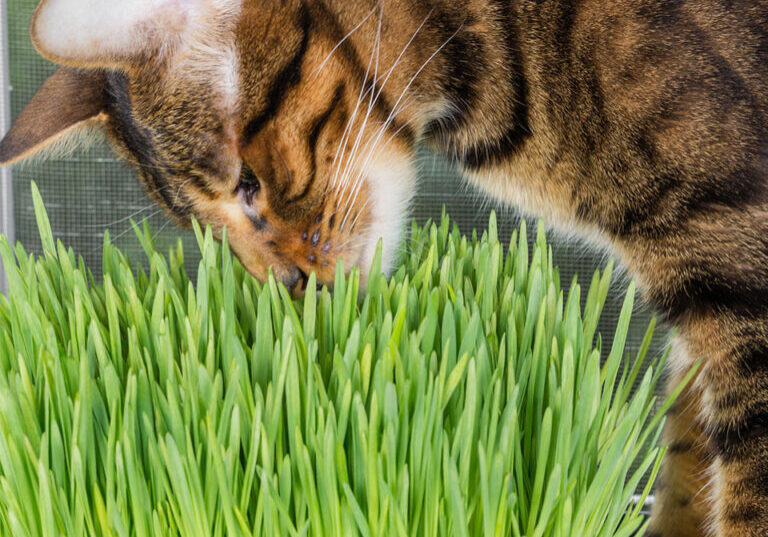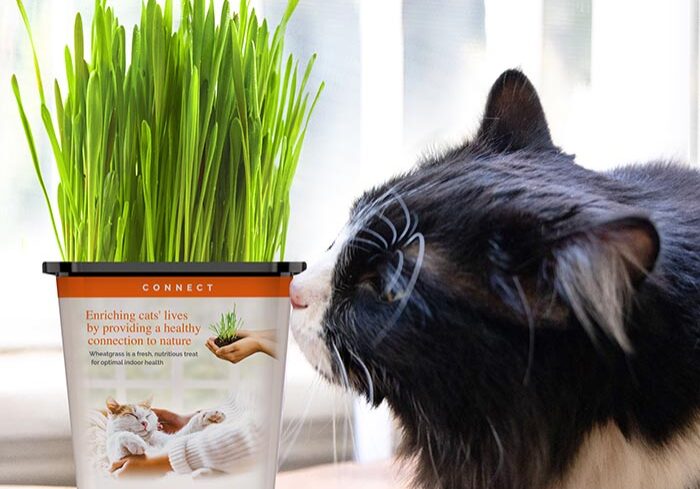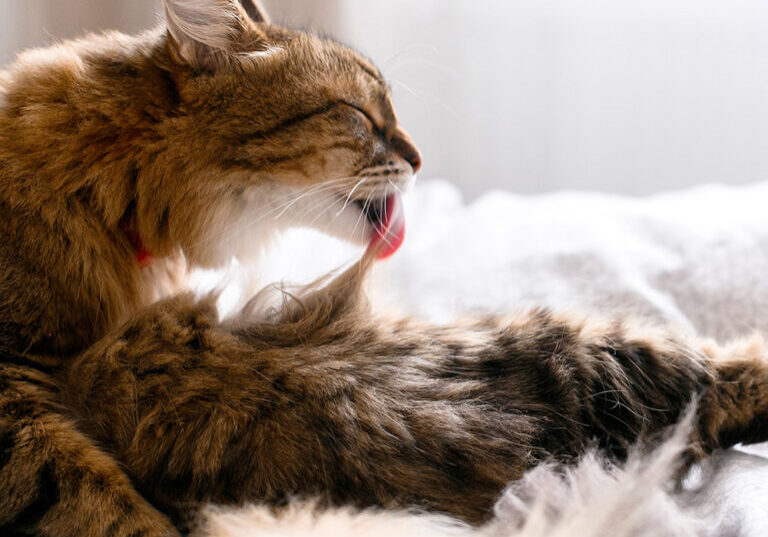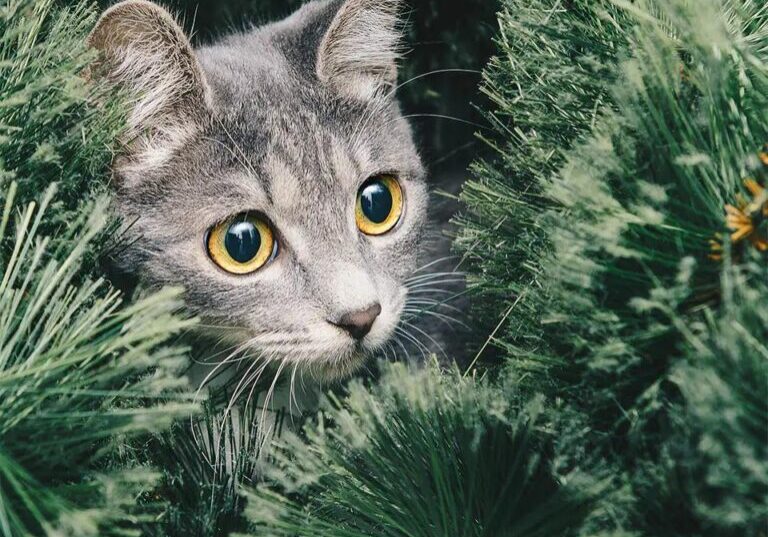Cat Grass:
THE ULTIMATE GUIDE from Pet Greens
By Marty Walls and Catherine Hoffmann

Grass for Cats?
Why cats and dogs eat grass
Have you ever wondered why your cat can’t resist nibbling on your favorite houseplants? Or why your dog tugs at the leash to chomp on a mouthful of lawn grass? While this quirky behavior may surprise some pet owners, experts on nutrition and pet care say your furry companions may be making attempts to say: We want our greens!
FAQ: Why does my cat eat grass?
OK, so your dog or cat may not be able to explain these seemingly odd indulgences, but one theory suggests that pets are instinctively attracted to chlorophyll-rich plants. While dogs are considered omnivores and cats carnivores, both are able to digest plants and utilize their nutrients.1
FAQ: Why does my dog eat grass?
Digestion is key: both cats and dogs benefit from the gentl
e natural fiber contained in Cat Grass (wheatgrass) - it’s a nutritional powerhouse and is beneficial to a wide variety of pets, including birds, reptiles, rabbits, hamsters, guinea pigs and other small animals.

SURVEY: U.S. Consumers Value Green Nutrition for Themselves and Their Pets
There is a growing awareness of the connection between greens and good health, according to a national survey commissioned by Pet Greens, the pet industry’s pioneer supplier of Cat Grass products. The survey of 640 dog and cat owners across the U.S shows consumers are eager to provide their animal companions with the nutritional and life-enriching benefits of having their own greens garden. In doing so, they just might inspire themselves to eat more of what they know is good for them. Here are a few highlights of what the green nutrition survey revealed about the importance of greens for people and their pets:
Green Nutrition – A Smart Move
- Green Beliefs
Out of 640 American dog and cat owners surveyed, a whopping 90 percent believe in the importance of green nutrition for their own diets. - Good for Me, Good for My Pet
An overwhelming majority (79 percent) of dog and cat owners surveyed say they would like to include green nutrition more often in their pets’ diets. - Healthy Gut = Happy Pet
We all know how important fresh green veggies are for our own digestion and how much better we feel as a result of including them in our diet. Our cats and dogs also feel better when their diets include the natural fiber and nutrients found in Cat Grass.

- To Green or Not to Green
Survey responses suggest pet owners ages 18-34 are more likely than those 35 or older to opt for green nutrition in treats for their dogs or cats, even at a higher cost (37 percent vs. 19 percent). - More Green for Greens
Sixty-five % on all in these paragraphs of those surveyed say they’d choose a green treat over a non-green treat for their pets, depending on the price. Twenty-five percent would be willing to pay more for them!
Is Cat Grass Good for Cats?
- A Fresh Approach to Indoor Wellness
Cat Grass offers a variety of ways to improve your cat’s quality of life: fun to play with and great to eat, nutrient-rich wheatgrass is known for its juicy, tender blades and sweet, earthy flavor. More than a cat treat, Pet Greens® Cat Grass is one of the best accessories for indoor cats, as a pretty touch of green on your cat’s window perch or cat tree. - Is Grass Good for Cats? A Safe Alternative to Houseplants and Outdoor Grass
Bring the Outdoors In and satisfy your indoor pet’s temptation to munch on potentially hazardous houseplants and harsh, chemically-treated outdoor grasses by offering them their own irresistible, luscious indoor garden to sniff, lick, paw and nibble on. - Education Is Part of Our Mission
While a growing number of health-conscious consumers are enthusiastic about including wheatgrass and other greens in their own diets, many lack an understanding of the specific applications and benefits when it comes to the overall health of our animal friends
Education and awareness are key factors in the ability of cat owners to provide that essential connection to nature so many indoor pets crave.

Wheatgrass for Cats
Properties, Delivery and Benefits
Wheatgrass is a young, green cereal grass originating from a wheat plant that is harvested before it develops gluten-forming grain kernels. Because of this early harvest, wheatgrass contains no wheat gluten.7 Wheatgrass is commonly juiced and served either alone or in a mixture with other juices. Other more convenient and portable forms of delivery include powders and tablets made by dehydrating the wheatgrass juice at low temperatures.
Wheatgrass is a nutritional powerhouse, rich in chlorophyll, antioxidant vitamins, minerals and other nutrients that support optimal health.8 Chlorophyll is often called the green blood of plants because its molecular structure closely mirrors the structure of heme molecules – the molecules that deliver oxygen to all parts of the body.
Antioxidant vitamins found in wheatgrass, such as vitamins A (as Beta Carotene), C, and E, help to reduce oxidation and the damage it may cause.6
Wheatgrass contains as much magnesium as broccoli, brussels sprouts, beets, carrots or celery. Magnesium is important for good muscle function and bowel health.11
Another nutritional property of wheatgrass is its high concentration of biotin, which is a crystalline form of vitamin B-complex, essential for the activity of many enzyme systems. According to the book Prescription for Nutritional Healing by James and Phyllis Balch, biotin is necessary for cell growth, the production of fatty acids, and the metabolism of fats and amino acids. Biotin also supports healthy hair, skin, sweat glands, nerve tissue, and bone marrow.

Affectionately nicknamed “liquid sunlight,” wheatgrass contains high concentrations of chlorophyll — the green pigment that acts as the blood or life force of plants, produced through exposure to the sun.
Wheatgrass contains no wheat gluten. This young, leafy green is harvested before it develops a gluten-forming kernel.
Wheatgrass for people - Cat Grass for pets
Cat grasses – whether they originate from wheat, barley, oats or rye – belong to the same family (Triticum) and have similar properties. However, research from agricultural scientist Charles Schnabel, regarded as one of the world’s foremost experts on cereal grasses, claims that 15 pounds of wheatgrass is equal in protein and overall nutritional value to nearly 350 pounds of garden vegetables - a 1 to 23 ratio.4,11

One Pound of Wheatgrass =
23 Pounds of Garden Veggies

Compared to other cereal grasses such as barley grass and oat grass, wheatgrass has the highest concentration of chlorophyll, the green pigment in plants that harnesses the sun’s energy through photosynthesis.12
CAT GRASS FOR EVERYONE
Besides cats and dogs, many other pets enjoy fresh Cat Grass.
Rabbits, reptiles, birds and small animals can all benefit from its nutritional properties along with the enhancement to their environment fresh plants provide. Sometimes they may like it a bit too much, in fact, so we recommend feeding small amounts initially - and of course the best thing to do is check with your veterinarian to determine the appropriate amount and method to feed each of your pets.


Reptiles: Add fine clippings to feeding bowl for a powerful source of calcium and antioxidant vitamins.

Small Animals: Feed small amounts from the pot or add clippings to food bowls.

Birds: Place near their perch for a tasty pruning and juicing treat.
GO GREEN! Nutritional Benefits for Animals
Greens are rarely found in a domestic pet’s commercially produced food. However, many experts believe that before animals were domesticated, greens were part of their daily diets.
Living in the wild, a dog or cat would have hunted birds, rodents or reptiles, consuming them whole and receiving green nutrients through the contents of the prey’s digestive tract. As an alternative for domesticated animals, cereal grasses, such as wheatgrass, may be added in moderate amounts to satisfy their attraction to greens.5


Cat Grass contains valuable vegetable-based fiber that cats used to get in the wild, which helps support healthy digestion.
What is Cat Grass? The Nutritional Benefits of Wheatgrass
Wheatgrass contains chlorophyll, antioxidant nutrients, vitamins A (as Beta Carotene), B-complex, C, E and K, minerals and a complete set of amino acids.7 This leafy green’s powerful nutrients are known to provide the following benefits:

Vitamin A is essential for an animal’s night vision, the maintenance of soft mucus tissues, and normal growth.6,8
Antioxidant vitamins and minerals found in wheatgrass help to protect fatty acids from oxidation.6
B-complex vitamins are vital to the health of the nervous system.6
Chlorophyll, or “liquid sunlight,” is the green pigment that acts as the blood or life force of plants, produced through exposure to the sun.11
Vitamin C is important in supporting a healthy immune system. It acts as an antioxidant nutrient in synergy with Vitamin E. Vitamin C also aids assimilation of essential minerals.6
Vitamin K helps regulate blood clotting and other clotting factors, and is essential for kidney function and bone metabolism.6

More than 700 plants have been identified as producing physiologically active or toxic substances that can cause harmful effects in animals. An extensive listing of potentially harmful plants can be found on The Humane Society or The American Animal Hospital Association websites.
Why Does My Cat Eat Grass?
Cat Grass can help deter pets from eating plants and outdoor grass
Many pet owners use wheatgrass to help discourage their pets’ appetites for potentially harmful house plants and chemically-treated outside grasses.5 While providing alternatives is an effective way to reduce the chances of your pet ingesting a toxic substance, pet care experts also advocate pet-proofing your house by removing poisonous plants or placing them in areas out of reach.
FAQ: Why is Cat Grass better than outdoor grasses?
As a cereal grass sprout, Cat Grass contains many nutrients that lawn grass does not, and it is also much more tender and easy to digest. It is the healthier, cleaner and safer choice to remove the temptation your pet may feel to eat outdoor grass – which may have been sprayed with chemicals, and which a variety of animals may have peed or pooped on!
Other Ways to Include Cat Grass in Your Pet’s Diet
If you don’t have time to grow your own wheatgrass from scratch, here are a few suggestions to consider when choosing options that best suit your lifestyle:
Pet Greens, the pet industry’s leading supplier of green nutrition products, stocks local pet store shelves with live, ready-to-use containers of Pet Greens certified organic Cat Grass (wheatgrass).
Ready-to-use containers of Pet Greens® Live Cat Grass® and Live Catnip are available in pet stores nationwide. Cat Grass can be nibbled from the pot or finely chopped into food.

One more easy and convenient way to get kitty greens into you home: fresh, fast and direct to your door!
Learn more about Cat Grass home delivery
Greens Dog Treats? Greens Cat Treats?
Pet Greens offers a convenient alternative to provide nutrient-rich wheatgrass for pets in healthy and delicious cat and dog treats. To locate a store in your area that carries Pet Greens products, visit the Store Locator

Infused with healthy greens

Infused with Cat Grass
Naturally Good! Meat, Poultry or fish is the #1 ingredient in all Pet Greens treats. Cat Craves and Li’l Treats contain NO animal by-products, NO artificial color or flavors, and NO corn or soy.
FAQ's: more about Pet Greens dog and cat treats
A Cat Celebration!
Fresh, live catnip plants provide life enrichment and are a great way to expand your kitty’s greens garden.
Encourages play and stimulates exercise
Indoor cats need an outlet, since they’re not out chasing lizards or climbing trees. Typical healthy feline behavior consists of short periods of intense activity followed by long naps, and a sprig or two of catnip is sure to trigger some fun time, even for the most dedicated couch potato.
Relieves boredom and eases anxiety
A bored cat can sometimes develop unwelcome behaviors, like clawing the furniture or - they’re favorite! - knocking things off shelves.

With their own personal catnip plant in the house, a bored cat will be able to find a healthy distraction, and often an anxious cat can be calmed by the euphoric properties of catnip.
Provides a healthy connection to Nature
Many cats enjoy eating catnip as well as responding to its pungent aroma – and it’s perfectly safe for them to do so. Pet Greens live catnip plants can be repotted for a year-round supply of fresh, tender kitty greens.
Why do cats eat grass?
Why do dogs eat grass?
While dogs are considered omnivores and cats carnivores, both are able to digest plants and utilize their nutrients.1
One theory suggests that dogs and cats used to get greens in the wild when hunting smaller grass-eating prey, but lack this green nutrition in domesticated diets. To satisfy their attraction to greens, cats and dogs may be tempted to eat harmful houseplants or chemicallytreated outside grasses. A safer, healthier
solution is a container of fresh, nutritious, 100 percent certified organic Pet Greens® Live Cat Grass®. You may choose to grow your own with Pet Greens® Garden and Medley self-grow Cat Grass kits, or purchase conveniently packaged Pet Greens® Treats made with organic wheatgrass.

Why is Cat Grass good for cats?
Cat Grass (wheatgrass) is packed with chlorophyll, carotene, antioxidant vitamins and minerals and other nutrients know to support development of healthy blood and muscle tissue.
Cat grass provides a safe alternative to potentially harmful household plants and chemically-treated outside grasses. According to a report by the American Society for the Prevention of Cruelty to Animals (ASPCA), eating small amounts of plants or grass is normal for cats, and as many as one in three housecats regularly munches on veggies.2
This powerful leafy green adds valuable fiber to help support healthy digestion. Cat grass is commonly used as a healthy dietary addition for cats, dogs, birds, reptiles and other small animals.

More Cat Grass FAQs
Does wheatgrass contain wheat gluten?
No - Cat Grass (wheatgrass) is a leafy green sprout harvested before it develops the gluten-forming grain.
Do I need to monitor how much Cat Grass my pet consumes?
Pets love wheatgrass and may devour it quickly, but they should only ingest a small amount of this nutrient-rich treat at a time. Rabbits, guinea pigs, or other smaller animals should be served Cat Grass in moderation. Give small clippings per serving or remove the Cat Grass after a few nibbles. Consult a veterinarian for advice on proper feeding amounts for each of your pets.
How can I introduce live Cat Grass to my pets?
Many pets eat Cat Grass straight from the container. However, some cats and dogs may not know how tasty these greens can be at first glance. If your cat or dog doesn’t take to Cat Grass right away, try misting it with water. Your cat or dog will lick the water and realize the greens are a tasty treat. If water doesn’t work, try adding clippings to your pet’s food. Pet Greens® Treats can also serve as a great way to introduce pets to the valuable green nutrients found in wheatgrass.

Love this Cat Grass Guide?
Discover everything you need to know about cat grass in our free, downloadable ebook. Your feline friend will thank you!
About Pet Greens® and the Pet Greens Family of Products
Based in San Marcos, California, Pet Greens is a certified organic grower of live Cat Grass and the pioneer supplier of green nutrition products for pets. In 1996, the company’s founders, Catherine Hoffmann and Marty Walls, launched the pet product industry’s first nationally distributed live Cat Grass and live catnip with major retailers and independent stores. The innovative duo created another industry first when they incorporated healthy greens into dog and cat treats. Pet Greens’ complete line of products infused with healthy greens includes: Pet Greens® Live Cat Grass® and Live Catnip; Pet Greens Treats for cats and dogs; and Pet Greens Garden and Medley self-grow Cat Grass kits. For more information, visit www.petgreens.com

RESOURCES
- National Research Council (U.S.) Ad Hoc Committee on Dog and Cat Nutrition, Nutrient Requirements for Dogs and Cats (Washington, D.C.: National Academies Press, 2006), p. 51,54,55,61,62,72,205-210.
- American Society for the Prevention of Cruelty to Animals (ASPCA), “Cats Who Eat Plants” http:// www.aspcabehavior.org/articles/96/Cats-WhoEat-Plants.aspx
- Wylde, RNC, DHMHS, HD, Bryce. “Holistic Healing: Wheatgrass.” Alive: Canadian Journal of Health & Nutrition; Nov 2006 Issue 289, p. 64-65.
- Balch, M.D., James, F., Balch, C.N.C., Phyllis, A. Prescription for Nutritional Healing 2nd ed. (New York: Avery, 2003), p. 54, 61 (in order of reference).
- Brown, Andi. Whole Pet Diet: Eight Weeks to Great Health for Dogs and Cats (Berkeley: Ten Speed Press, 2006), p. 143, 176, 138 (in order of reference).
- Poutinen, C. J. The Encyclopedia of Natural Pet Care (New York: Mc Graw-Hill, 2000), p. 326, 328, 398, 101, 99, 439, 102 (in order of reference).
- Meyerowitz, Steve. Wheatgrass Nature’s Finest Medicine: The Complete Guide to Using Grasses to Revitalize Your Health 7th ed. (Summertown, TN: Sproutman Publications, 2006), p. 101, 46, 159 (in order of reference).
- Poutinen, C. J. Natural Remedies for Dogs and Cats (New York: Gramercy Books, 2003), p. 81, 155 (in order of reference).
- Gruskin, B. “Chlorophyll — its therapeutic place in acute and suppurative disease.” American Journal of Surgery 49 (1940): p. 49-55.
- Pitcairin, Richard H. and Susan. Dr. Pitcairin’s New Complete Guide to Natural Health for Dogs and Cats 3rd ed. (Emmaus, PA: Rodale Inc., 2005), p. 144.
- Wigmore, Ann. The Wheatgrass Book: How to Grow and Use Wheatgrass to Maximize Your Health and Vitality (New York: Avery, 1985) p. vii, 49.
- Balch, C.N.C., Phyllis, A. Prescription for Dietary Wellness: Using Foods to Heal 2nd ed. (New York: Penguin Group, 1992) p. 33








